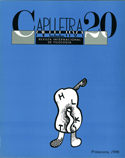L'evolució de les e (breu) i o (breu) + iod en català dins la Romània
DOI:
https://doi.org/10.7203/caplletra.20.7351Keywords:
evolució de vocals llatines, iod, català, llengües romàniques Abstract
Abstract
This work is a discussed exposition, with references to Romance languages nearer to Catalan, of two hypotesis which have tried to explain peculiar evolution e > [í] and o > [ú] because of the iod in Catalan. The most accepted explanation says the iod was the cause of diphthongation of both vowels (the same as in Occitan) and after this they monophthongized in [í] and [ú] respectivelly, But I try to notice you, by following the line that Badia Margarit in his Gramàtica suggested, also it could be accepted an explanation based on direct inflection of open vowels (the same as in Castilian and Portuguese).
 Downloads
Downloads
Downloads
Published
How to Cite
-
Abstract430
-
PDF (Català)588
Issue
Section
License
Authors submitting work to Caplletra for publication must be the legitimate holder of the usage rights. Legitimacy for the purposes of publishing the work must also include images, tables, diagrams and any other materials that may complement the text, whether they are the author of such material or not.
Copyright: on publishing their work in the journal, the author grants Caplletra. Revista Internacional de Filologia usage rights (reproduction, distribution and public communication) for both the paper printed version and for the electronic version.
All work published in Caplletra is covered by the Creative Commons license type Attribution-NonCommercial-NoDerivatives 4.0 (CC BY-NC-ND 4.0).
RESPONSABILITY
Caplletra. Revista Internacional de Filologia does not necessarily identify with the points of view expressed in the papers it publishes.
Caplletra. Revista Internacional de Filologia accepts no responsibility whatsoever for any eventual infringement of intellectual property rights on the part of authors.






